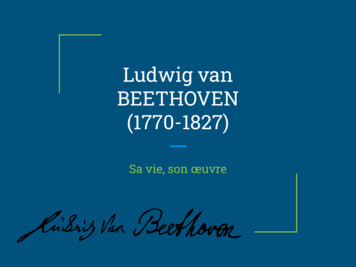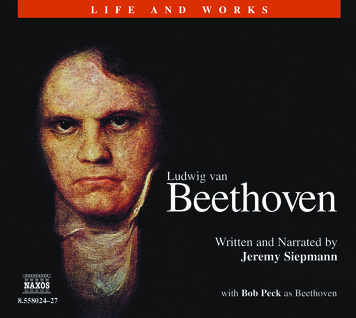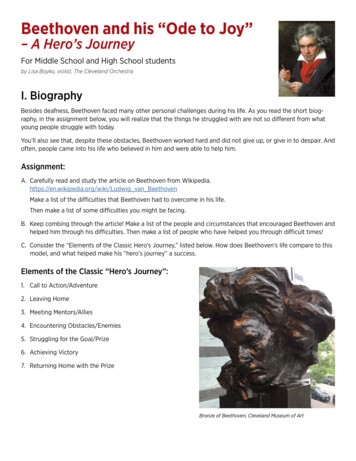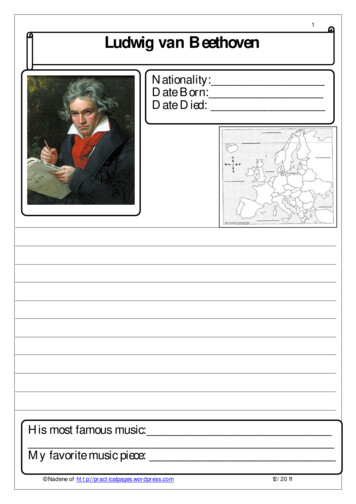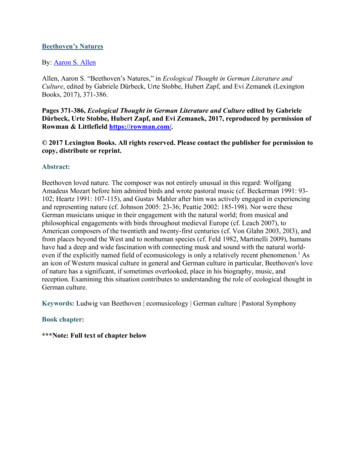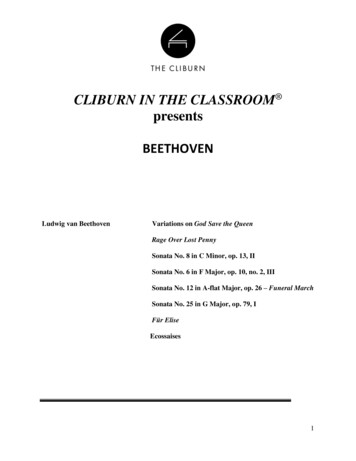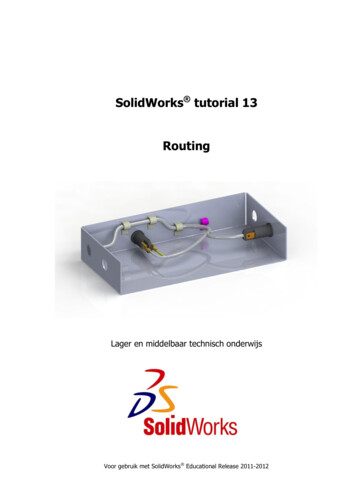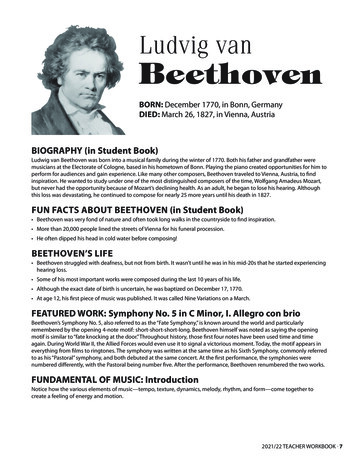
Transcription
Ludvig vanBeethovenBORN: December 1770, in Bonn, GermanyDIED: March 26, 1827, in Vienna, AustriaBIOGRAPHY (in Student Book)Ludwig van Beethoven was born into a musical family during the winter of 1770. Both his father and grandfather weremusicians at the Electorate of Cologne, based in his hometown of Bonn. Playing the piano created opportunities for him toperform for audiences and gain experience. Like many other composers, Beethoven traveled to Vienna, Austria, to findinspiration. He wanted to study under one of the most distinguished composers of the time, Wolfgang Amadeus Mozart,but never had the opportunity because of Mozart’s declining health. As an adult, he began to lose his hearing. Althoughthis loss was devastating, he continued to compose for nearly 25 more years until his death in 1827.FUN FACTS ABOUT BEETHOVEN (in Student Book) Beethoven was very fond of nature and often took long walks in the countryside to find inspiration. More than 20,000 people lined the streets of Vienna for his funeral procession. He often dipped his head in cold water before composing!BEETHOVEN’S LIFE Beethoven struggled with deafness, but not from birth. It wasn’t until he was in his mid-20s that he started experiencinghearing loss. Some of his most important works were composed during the last 10 years of his life. Although the exact date of birth is uncertain, he was baptized on December 17, 1770. At age 12, his first piece of music was published. It was called Nine Variations on a March.FEATURED WORK: Symphony No. 5 in C Minor, I. Allegro con brioBeethoven’s Symphony No. 5, also referred to as the “Fate Symphony,” is known around the world and particularlyremembered by the opening 4-note motif: short-short-short-long. Beethoven himself was noted as saying the openingmotif is similar to “fate knocking at the door.” Throughout history, those first four notes have been used time and timeagain. During World War II, the Allied Forces would even use it to signal a victorious moment. Today, the motif appears ineverything from films to ringtones. The symphony was written at the same time as his Sixth Symphony, commonly referredto as his “Pastoral” symphony, and both debuted at the same concert. At the first performance, the symphonies werenumbered differently, with the Pastoral being number five. After the performance, Beethoven renumbered the two works.FUNDAMENTAL OF MUSIC: IntroductionNotice how the various elements of music—tempo, texture, dynamics, melody, rhythm, and form—come together tocreate a feeling of energy and motion.2021/22 TEACHER WORKBOOK 7
Classroom activities provided by Jennifer Sonstroem, Laurel Park Elementary, Wake CountyCLASSROOM ACTIVITY #1: Listening for a MotifNORTH CAROLINA ESSENTIAL STANDARDS IN MUSIC:4.MR.1Understand the interacting elements to respond to music and music performances.4.ML.3.3 Create rhythmic compositions which include the use of whole, dotted half, half and quarter notes; whole, halfand quarter rests; and beamed eighth notes in duple and triple time and which are arranged using a variety ofsound sources.4.ML.2.4 Use standard symbols to notate rhythm, meter, and dynamics in simple patterns4.CR.1Understand global, interdisciplinary, and 21st century connections with music.OBJECTIVE:Students will listen to and evaluate the main melodic motif in Beethoven’s Symphony No. 5. Students will then compose asimilar motif with a partner or in a small group setting using either xylophone and/or Chrome Music Lab.MATERIALS: North Carolina Symphony Education Concert video: Symphony No. 5 in C Minor Opening Motif Visual Visual Listening Map Chrome Music Lab - Visual Listening Map Orff Instruments Paper/pencil, audio recording device White board or screenPROCESS:1.Play the first few phrases from the Education Concert video and have students name the composer and title.2.Ask the following questions:a. Why do you think this piece is so recognizable?b. How many notes do you hear in the first measure? Select a student to hum the musical idea.c. Play 0:03–0:06. How many notes are in the second measure?d. Were the two short phrases exactly the same, different, or similar?3.Explain that a short musical idea or short phrase is a motif (sometimes spelled “motive”). Provide examples of a motif(eg “Jaws” is a 2-note motif )a. Does Beethoven’s motif have repeated pitches?b. How many pitches are the same? Then what happens?4.Play 0:00–0:06. Have students count how many times the motif ‘ti-ti-ti ta’ occurs.5.Display the Opening Motif Visual and distribute copies.6.Students will mark Xs for the first two times the motif is heard at the beginning, and continue marking an X eachtime the motif is heard.7.Play :00-:20. Have students share their answers of how many times they heard the motif.a. Think/pair/share or turn to talk with their neighbor.b. Different answers provide a good reason to listen to the recording again to re-check answers.8.Show students the Visual Listening Map and discuss how the motif is shown throughout, as texture changes fromone family of instruments playing it to the entire orchestra.9.Mallets and/or Chrome Lab experimentationa. Have students work with a partner or in a small group and share one mallet instrument between them. Studentswill compose a motif similar to Beethoven’s, with 3 repeated notes followed by a different note that is a certainnumber of xylophone bars away from the first one.8 NORTH CAROLINA SYMPHONY
b. Then, the pair should do a self-assessment, make revisions, and decide upon a sequence of four occurrences oftheir motif that they will share with the class and write it down on paper any way that they want to.c. Video record the pieces on mallet instruments and play back the video for the class.d. Have students work collaboratively in small groups or individually in Chrome Music Lab. Choose aninstrument (marimba, piano, electronic) and begin writing a motif similar to Beethoven’s. Use the rhythmti,ti,ti, ta (short, short, short, long ).e. Have students present their work to see which ones sound the most similar to the original motif and which onessound different. How are these the same or different from the original? Intervals? Instruments? Rhythms?f. Ask them to explain their process for composing and evaluate their own composition and performance10. Discussion Questionsa. What was the name of this famous piece, and who wrote it?b. How many notes were in Beethoven’s motif for this piece?c. How was your composition a little bit like Beethoven’s?11. Classroom Activity Extensiona. Play the entire recording and have students count how many times the motif is heardb. Play the second movement of Beethoven’s Symphony No. 7. Listen for the rhtyhmic motif, “ta, ti-ti, ta, ta” usedthroughout the work.c. Share Visual Listening Map of Beethoven Symphony No. 7.Opening Motif Visual2021/22 TEACHER WORKBOOK 9
CLASSROOM ACTIVITY #2: Playing Along with the MusicNORTH CAROLINA ESSENTIAL STANDARDS IN MUSIC:4.ML.1.1 Apply expressive qualities when singing or playing a variety repertoire of music representing genres and stylesfrom diverse cultures.4.ML.2.1 Interpret rhythm patterns, including whole, half, dotted half, quarter, and eighth notes and rests in 2/4, 3/4, and4/4 meter signatures.4.ML.2.2 Interpret through voice and/or instruments simple pitch notation in the treble clef in major keys.4.ML.2.3 Interpret standard symbols and traditional terms for dynamics, tempo, and articulation while performingmusic.4.MR.1.1 Illustrate perceptual skills by moving to, answering questions about, and describing aural examples of music ofvarious styles and cultures.4.MR.1.3 Design a set of criteria for evaluating music performances and compositions.OBJECTIVE:Students will interpret the sound and symbol systems of musical notation by following a simplified score. Students willthen play percussion instruments, looking and listening for expressive qualities in the music. Class will decide on criteriafor self-assessment.MATERIALS: North Carolina Symphony Education Concert video: Symphony No. 5 in C Minor Simplified Score for Non-Pitched Percussion Assorted classroom instruments: Agogo, cowbell, triangles, finger cymbals Audio recording device White board or screenPROCESS:1.Explain what a musical score is and how a conductor uses it to conduct.2.Play :00-:23 and have students follow along with the simplified score.a. Explain how the three staves are connected and therefore happen simultaneously. As students listen, they willread vertically and horizontally, paying close attention to dynamics. Review piano, forte, fortissimo, and crescendo.b. Have students share the dynamic markings indicated3.Explain what a fermata is, and have students play the bottom line while patting or patsching their thighs. Longernote values may be shown by sliding hands toward the knee.4.Practice the middle line while using a two-finger clap, sliding across the hand for longer notes. Put the bottom lineand middle lines together with half of the class patting and half clapping.5.Practice the top line while snapping, extending the snap upward for held notes.6.Put all three lines together by dividing the class into three groups.7.Transfer the three parts to the percussion instruments listed in the score. Students may offer suggestions for the firsttwo non-pitched percussion parts. Emphasize following the conductor (or teacher) and noticing how the conductorshowed the expression of the music and interpreted it. Tell students to be sure to play their instrument at the correctvolume.8.Continue rotating students to play a different instrument/part. Explain how large and small gestures were used toindicate how loud or soft to play.9.Invite class to decide upon criteria to evaluate their performance. Write these on the board. Examples include: properplaying technique; played with proper expression; followed the conductor.10. Record the class and play it back, allowing the class to make refinements and evaluate their performance.10 NORTH CAROLINA SYMPHONY
11. Discussion Questionsa. What is a musical score?b. What is a fermata?c. What does a conductor do?d. What is the difference between a composer and a conductor?e. Can someone be both a composer and a conductor? Yes! Beethoven, Stravinsky, CoplandSimplified Score for Non-Pitched Percussion2021/22 TEACHER WORKBOOK 11
CLASSROOM ACTIVITY #3: Listening for Major and Minor KeysNORTH CAROLINA ESSENTIAL STANDARDS IN MUSIC:4.ML.1Apply the elements of music and musical techniques in order to sing and play music with accuracy andexpression.4.ML.1.3 Use voice and/or instruments to execute melodic movement through pentatonic melodies on the treble staff.4.ML.2Interpret the sound and symbol systems of music.4.ML.2.1 Interpret rhythm patterns, including whole, half, dotted half, quarter, and eighth notes and rests in 2/4, 3/4, and4/4 meter signatures.4.ML.2.2 Interpret through voice and/or instruments simple pitch notation in the treble clef in major keys.4.MR.1Understand the interacting elements to respond to music and music performances.4.MR.1.1 Illustrate perceptual skills by moving to, answering questions about, and describing aural examples of music ofvarious styles and cultures.4.CR.1Understand global, interdisciplinary, and 21st-century connections with music.OBJECTIVE:Students will listen and recognize the difference between major and minor scales/keys and share their ideas about thepopularity of Beethoven’s Symphony No. 5. Students will learn to play the opening motif on pitched percussion andutilize ear training.MATERIALS: North Carolina Symphony Education Concert video: Symphony No. 5 in C Minor Xylophones (Orff Instruments) or keyboards Simplified Score for Pitched Percussion Paper practice xylophone Audio recording device White board or screenPROCESS:1.Play :00-:09 and have students identify major versus minor key signatures using the following hand motions:a. If major, form a large “M” with fingers of both hands.b. If minor, use sign language to form a small “m” by wrapping three fingers over the thumb.2.Ask the following questions:a. Does the beginning sound dark and urgent, as if to say “watch out?” Yes, most sources agree the motif meant“Fate knocks at the door.”b. Why do you think this piece is so famous and popular? Have students share their answers, letting them know thatthere are no right or wrong answers, just opinions that may differ and create interesting perspectives.3.Tell the class that they are going to learn how to play the beginning of this piece on the pitched percussion (Orffmallet) instruments.4.Explain that the original piece is in a key or tonality that won’t work on pitched percussion because some notes aremissing. Instead, play it in the next higher key, using the “home tone” of D.5.Review proper mallet technique. Distribute “Paper Practice Xylophone, basic,” and replace the Bs with B-flats.Students may do this at the barred instruments, picking up the bars carefully with one hand on each end.6.Give students the beginning note of A and see if they can figure out how to play the opening by ear. Ask thefollowing questions:a. How many times will you play A? 3b. Is the next note higher or lower? Lowerc. Can you figure out what the next note is? Fd. After that note is held out, is the next note higher or lower? One step higher, Ge. Will it then skip down the same way as the first time? Yes, down to E12 NORTH CAROLINA SYMPHONY
7.Display the “Simplified Score for Pitched Percussion” and discuss as a whole. Explain what a key signature is and that aD-minor scale uses a flat or black key on the piano.8.Play :00-:22 and have students follow along with score while listening.9.Teach the parts, having students identify note names, finding them on their paper xylophones and playing the partsslowly. Students should alternate hands whenever possible.10. Transfer the learning to pitched percussion instruments and have students take turns playing.11. Record the students’ performance with or without the recording and then play it back, asking the class to identifycriteria for evaluation, including: rhythmic accuracy or fluency, expression, or the ability to follow the conductor.12. Discussion Questionsa. What is the tonality of music and how is it shown in printed music? Tonality is the scale the music is based on or thekey the music is in, shown in printed music by a key signatureb. What are two common scales or tonalities used in music? Major and minorc. Which of these did we concentrate on today? Minord. Why couldn’t we play our Orff instruments with the recording today? We were playing in a different key than therecording2021/22 TEACHER WORKBOOK 13
14 NORTH CAROLINA SYMPHONY
Simplified Score for Pitched Percussion2021/22 TEACHER WORKBOOK 15
EXTENSION ACTIVITY: Beethoven’s Life and Legacy – Motif and MeaningNORTH CAROLINA ESSENTIAL STANDARDS IN MUSIC:4.MR.1Understand the interacting elements to respond to music and music performances.4.MR.1.1 Illustrate perceptual skills by moving to, answering questions about, and describing auralexamples of music of various styles and cultures.4.MR.1.2 Explain personal preferences for specific musical works and styles, using appropriate music terminology.4.MR.1.3 Design a set of criteria for evaluating music performances and compositions.OBJECTIVE:Students will listen to the original version and write a journal entry about the 4-note motif heard at the beginning ofBeethoven’s Fifth Symphony based on biographic research. They will listen to at least three other versions of SymphonyNo. 5 and design a set of criteria for evaluating music performances and compositions by explaining their personalpreferences.MATERIALS: North Carolina Symphony Education Concert video: Symphony No. 5 in C MinorPROCESS:1.Have students watch the North Carolina Symphony Education Concert video of Beethoven’s Symphony No. 5 and askthe following questions:a. What does the motif heard in the very beginning of the piece mean to you?b. What do you think the piece is about?c. What do we know about Beethoven’s life during this middle period?d. Did he leave notes about his intent? Research Ludwig Van Beethoven in your media center or with yourteacher’s help.e. What are some alternative versions of the familiar motif (short melody that is repeated, unifying the piece) used inBeethoven’s 5th symphony?2.Listen to various interpretations and alterations of the familiar motif from Beethoven’s Symphony No. 5. What dothese versions have in common? How are they different?a. Discob. Rockc. Jazzd. Cuban Style Piano3.Design a set of criteria for evaluating music performances in order to determine the most enjoyable version.a. Was this version aligned with the composer’s original intent?b. Was it contrasting? What made it similar or contrasting?c. Did you like how the arrangement was performed? Explain your personal preferences for why you selected theversion you did as your preferred arrangement.d. What was it about the performance that made it enjoyable?16 NORTH CAROLINA SYMPHONY
NORTH CAROLINA SYMPHONY EDUCATION SUPPORTERSThese concerts are made possible by a generous grant-in-aid from the State of North Carolina,the Honorable Roy Cooper, Governor; D. Reid Wilson, Secretary, North Carolina Department ofNatural and Cultural Resources. NCS also gratefully acknowledges the following supporters:EDUCATIONSUSTAINERS( 50,000 )EDUCATIONBENEFACTORS( 25,000 )EDUCATIONPATRONS( 10,000 )Anonymous, Anonymous Trust / Simple Gifts Fund,The Bastian Family Charitable FoundationRobert P. Holding Foundation, Inc., Ina Mitchell Jordan Endowment Fund, Samuel P. Mandell Foundation, Youths’ Friends Association Inc.EDUCATION PARTNERS ( 1,000 )Alamance County GovernmentAnonymous FundAshe County Community FoundationThe Harold H. Bate FoundationBeane Wright FoundationBell Family FoundationBertsch Family Charitable Foundation, Inc.BlueCross BlueShield of North CarolinaThe Borden Fund, Inc.R.A. Bryan Foundation, Inc.Carteret Community FoundationChowan Community Funds FoundationThe Cole FoundationMr. and Mrs. Jeffrey A. CorbettCorning Incorporated FoundationEdna Williams Curl and Myron R. CurlCharitable FundThe Dickson Foundation, Inc.William C. Ethridge Foundation, Inc.The Lundy Fetterman Family Foundation TrustGipson Family FoundationGranville County Community FoundationIredell County Community FoundationMoore County Community FoundationRete Mirabile FundOnslow Caring Communities FoundationOnslow County GovernmentOuter Banks Community FoundationJames J. and Mamie Richardson PerkinsMemorial FundPoole Family FoundationPrescott Family Charitable TrustW. Trent Ragland, Jr. FoundationRockingham County Community FoundationThe Florence Rogers Charitable TrustThe Norman and Rose S. Shamberg FoundationThe Eddie and Jo Allison Smith FamilyFoundation, Inc.Southern Bank FoundationSwearingen FoundationVance County Community FoundationAlex and Barbara Wilson CharitableFoundation, Inc.The Woman’s Club of RaleighMargaret C. Woodson FoundationYadkin County Community FoundationMUSIC EDUCATIONENDOWMENT FUNDSThe Joseph C. and Diane E. Bastian Fundfor Music EducationThe Ruby and Raymond A. BryanFoundation FundThe Mary Whiting Ewing CharitableFoundation FundThe Hulka Ensemble and Chamber MusicPrograms FundThe Janirve Foundation FundThe Elaine Tayloe Kirkland FundThe Ina Mae and Rex G. PowellWake County Music Education FundSCHOOL SYSTEM SUPPORTERSChapel Hill-Carrboro City SchoolsCumberland County SchoolsDurham Public SchoolsEdgecombe County SchoolsHarnett County SchoolsLee County SchoolsNew Hanover County SchoolsOrange County SchoolsWake County Public SchoolsSupporters are current as of September 2021Authors: Kim Demery, Monica Jones, Jennifer Sonstroem, Lindsay WilliamsDesigner: Jennifer Blackman, Graphic Designer, North Carolina SymphonyEditors: Jason Spencer, Director of Education, North Carolina Symphony; Christopher Short, Education Assistant, North Carolina Symphony;Ryan Godwin, Education Intern, North Carolina SymphonyNorth Carolina Symphony, 3700 Glenwood Avenue, Suite 130, Raleigh, NC 27612, 919.733.2750, or toll free 877.627.6724www.ncsymphony.org/educationNorth Carolina Symphony Student and Teacher Handbook 2021 by North Carolina Symphony Society, Inc. Reproduction of this bookin its entirety is strictly prohibited.
BIOGRAPHY (in Student Book) Ludwig van Beethoven was born into a musical family during the winter of 1770. Both his father and grandfather were musicians at the Electorate of Cologne, based in his hometown of Bonn. Playing the piano created opportunit
